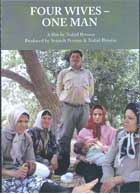
Four Wives – One Man 2007
Distributed by Women Make Movies, 462 Broadway, New York, NY 10013; 212-925-0606
Produced by Setareh Persson & Nahid Persson
Directed by Nahid Persson
DVD, color, 76 min.
College - Adult
Middle Eastern Studies, Iran, Women's Studies, Sociology, Marriage, Polygamy
Date Entered: 09/03/2008
Reviewed by Malcolm L. Rigsby, Department of Sociology, Ouachita Baptist University, Arkadelphia, ARBorn and raised in Iran, Nahid Persson, the director of Four Wives – One Man is in part a product of the 1979 Iranian Revolution. Not only has she voiced protest against the Shah’s reign, but also the Islamic Republic of Iran which followed the Shah’s flight from Iran. For the past 25 years she has lived in Sweden, been involved in media and used film making as perhaps her most preferred venue for presenting social and political issues in both a sensitive and naked way.
It should be noted that this documentary primarily depicts a style of family life most prevalent in rural rather than urban Iran. Anyone interested in women’s rights and family life around the world will find this documentary thought provoking, creating a desire to learn more.
The film follows the lives of four women who are married to one man (Heda). Though the film does not overtly indicate the time which transpires between the introduction and the conclusion the audience may infer that 2 – 3 years pass in the lives of the women. The man, Heda, is a rural and prosperous farmer. He proudly notes that his income and sheep allow him to make all the wives happy and provide for his twenty children and aging mother. Through the use of subtle statements, we sense that the sheep may have been the fourth wife’s property before marriage to Heda.
We are quickly intrigued by the way the wives joke among themselves in one scene only in the next scene to speak grudgingly of the others. It is as if they seek laughter and dialog with each other in order to maintain their individual mental ability to deal with the hardships of life, managing their own individual household and family, and dealing with Heda.
The four wives Farang (the first wife), Goli (2), Shahpar (3), and Ziba (the fourth wife) at different points reflect on the introduction of each new wife. For instance, Farang tells us that she opposed marriage of Heda to Goli, but was beaten for taking a stand against Heda and acquiesces. Shahpar’s method to try to sway Heda not to take a fourth wife was to insist that she “will kill” if Heda marries again. Each wife though relents to the next wife and so feels neglected as the new wife receives more physical and emotional recognition from Heda.
Often funny, other times sorrowful, but at all times heartfelt, Four Wives – One Husband is beautifully shot in vivid cinematography. Scripting seems effortless as we travel to the seashore for a family picnic; relive family events such as a broken kitchen faucet, or the butchering of a sheep and division of the carcass among the four wives’ families. This film is frank and the language sometimes harsh and perhaps offensive. In any event, I invite you to view this sensitive yet open film about family issues and polygamy in Iranian rural culture today.
Suggested Questions of Interest for Discussion:
- Why is Heda in the film’s title referred to as “one man” rather than “one husband”?
- The concept of the need of “love” in marriage as expressed by the wives as opposed to the need of a “man to have a woman” as expressed by Heda.
- The advice given by Farang (the second wife) regarding the need of her daughter to find a husband and her statement “A good husband is more important than food on the table”.